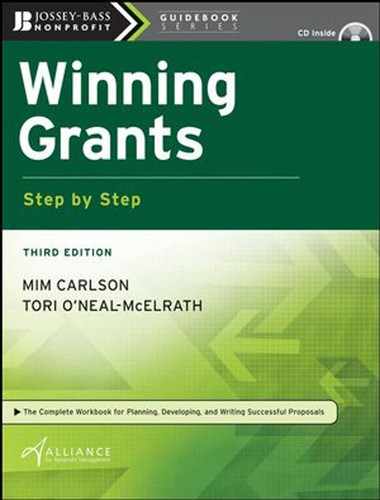Tips for Writing the Methods Component
• Sync your organization’s methods to the program’s objectives and need statement.
• Tie your methods to the resources you are requesting in the program budget. Each activity should match its corresponding cost exactly.
• Explain the rationale for choosing these methods; talk in terms of research findings, expert opinion, and the organization’s past experience with similar programs.
• Spell out the facilities and capital equipment that will be available for the project.
• Build various activity phases on top of one another to move the effort toward the desired results. Include a timeline.
• Be sure to discuss who will be served and how they will be chosen.
• Do not assume the program officer knows more than any woman on the street is likely to know about your nonprofit or what you propose.
Sample Timeline (Abbreviated Version)

Look over the Sample Methods Component for the Some City Senior Center’s project. Then develop your organization’s methods by completing Worksheet 5.1A, which asks you to list the key elements of the organization’s planned program. Consult Worksheet 5.1B, which contains an example of a completed list of methods, as necessary. Then use the Sample Methods Component as a guide as you write your own methods section for your proposal. (The sample shows the methods for one objective. Additional objectives would be handled the same way.) Finally, use the Methods Review Questions to review your organization’s methods, just as you did for your organization’s need statement and goals and objectives.
Sample Methods Component
In order to achieve the objectives for our Senior Latino Community Outreach Pilot Project, Some City Senior Center will employ the methods outlined below. We have confidence in these methods, as they have been tested and proven successful by two of our fellow nonprofit organizations whose client populations are Latino: Health Access Latinos in Some City and the XYZ Community Clinic in Valley Vista. Representatives of both organizations served as advisers to us as we developed this pilot project.We have also prepared a detailed timeline, which is included in the appendixes to this proposal.
Objective One
Ensure that a minimum of 75 Spanish-speaking seniors with Type II diabetes who complete our disease management classes maintain stabilized blood sugar levels for three consecutive months.
Methods
• Some City Senior Center will hire a program assistant and a full-time bilingual nurse who specializes in chronic disease management. Establish an outreach committee cochaired by two of our Latino and/or Spanish-speaking board members and including diverse community representation (geography, race, ethnicity, gender, and occupation).
• The bilingual nurse and program assistant will adapt the center’s current diabetes self-management classes, including classroom tools and materials, to make them linguistically and culturally appropriate for Spanish-speaking seniors.
• The bilingual nurse and program assistant will develop the protocols for testing and tracking program participants for three consecutive months after completing the classes.
• Staff will develop a formal referral system and feedback mechanism between our center and all appropriate community agencies positioned to provide referrals to our Spanish-speaking diabetes management classes.
• Staff will hold weekly Spanish language diabetes self-management classes.
• Staff will track participants’ progress on a weekly basis for three months following completion of the classes.
• The program assistant will formally chart the progress of each participant.
WORKSHEET 5.1A: Methods Exercise
Winning Grants Step by Step,Third Edition. Copyright © 2008 by JohnWiley & Sons, Inc. All rights reserved.

WORKSHEET 5.1B: Methods Exercise Example
Winning Grants Step by Step,Third Edition. Copyright © 2008 by JohnWiley & Sons, Inc. All rights reserved.

Methods Review Questions
1. Do the methods discussed in the proposal derive logically from the need statement and the goals and objectives?
2. Do the methods present the program activities to be undertaken?
3. Have you explained why you selected the specific methods or activities?
4. Have you explained the timing and order of the specific activities?
5. Is it clear who will perform specific activities?
6. Given the organization’s projected resources, are the proposed activities feasible?
If you have been following along with each step, including testing each of your proposal components against the questions at the end of each, you are now in prime position to be successful in the next step: developing your evaluation component.
..................Content has been hidden....................
You can't read the all page of ebook, please click here login for view all page.
